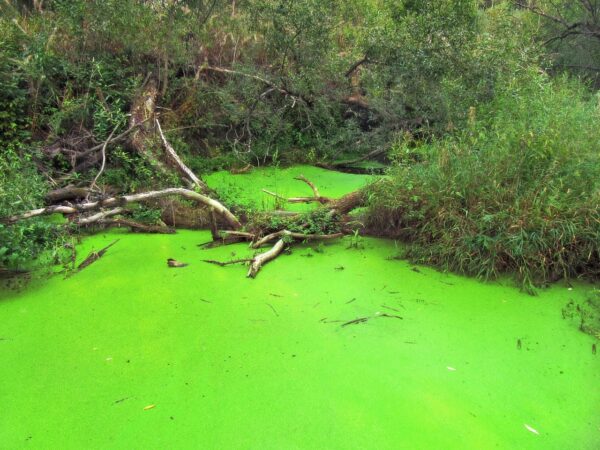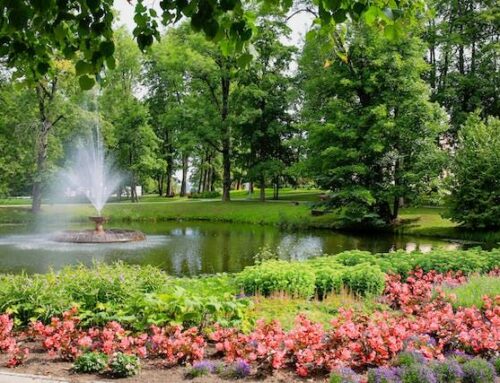As the summer sun starts to beat down on our gardens, pond owners often face a familiar challenge: the dreaded algae bloom. These sudden explosions of green can turn a crystal-clear pond into a murky mess seemingly overnight. While chemical solutions have long been the go-to for many, there’s a growing movement towards more natural, probiotic approaches to algae management. That’s why we want to take a quick look at how you can prevent and manage algae blooms in your summer pond using eco-friendly, probiotic methods that work in harmony with your pond’s ecosystem.
Understanding Algae Blooms
What causes algae blooms in the first place? Algae are a natural and necessary part of any pond ecosystem, providing oxygen and serving as a food source for various aquatic creatures. However, when conditions are right – typically warm temperatures combined with an excess of nutrients in the water – algae can reproduce rapidly, leading to a bloom.

These blooms not only look unsightly but can also be harmful to your pond’s inhabitants. As algae die off, they consume oxygen in the water, potentially leading to fish stress or even die-offs in severe cases. Additionally, some types of algae, such as cyanobacteria, can produce toxins that are harmful to fish, pets, and even humans.
The Probiotic Solution: Nature’s Way of Balancing
Enter probiotics – the good bacteria that can help restore balance to your pond’s ecosystem. Just as probiotics in our diet can aid digestion and boost our immune system, pond probiotics work to create a healthier aquatic environment. These beneficial bacteria compete with algae for nutrients, effectively starving them out over time.
Probiotic solutions for ponds typically contain a blend of naturally occurring bacteria and enzymes. These microorganisms work tirelessly to break down excess nutrients, organic matter, and sludge that accumulate in your pond. By reducing these food sources for algae, probiotics help prevent blooms before they start and can even help clear existing ones.
Implementing a Probiotic Regimen
Starting a probiotic treatment for your pond is relatively simple. Most probiotic products come in liquid, pellet, or powder form and can be added directly to your pond water. It’s important to follow the manufacturer’s instructions for dosage, as this can vary based on your pond’s size and current condition.
For best results, begin your probiotic regimen early in the season, before algae have a chance to take hold. Regular, consistent application is key – think of it as a ongoing wellness program for your pond rather than a one-time fix. Many pond owners find success with weekly treatments throughout the warmer months, adjusting as needed based on their pond’s response.
It’s worth noting that you may not see instant results with probiotic treatments. Unlike chemical solutions that can clear algae quickly (but often temporarily), probiotics work more gradually to restore balance to your pond’s ecosystem. Patience is key – over time, you’ll likely notice clearer water, reduced algae growth, and healthier, more vibrant aquatic life.
Complementary Natural Strategies for Managing Algae Blooms
While probiotics can be a powerful tool in your algae-fighting arsenal, they work best as part of a holistic approach to pond care. One of the most effective complementary strategies is the use of aquatic plants. Water lilies, lotus, and floating plants like water lettuce not only add beauty to your pond but also provide shade that helps keep water temperatures down and reduces sunlight available for algae growth.
Submerged plants like hornwort and anacharis are particularly effective at competing with algae for nutrients. These underwater workhorses absorb excess nutrients directly from the water, leaving less for algae to feed on. As an added bonus, they provide oxygen and habitat for fish and other aquatic creatures.
Another natural ally in your fight against algae is proper filtration. A well-maintained biological filter provides a home for beneficial bacteria, supporting your probiotic efforts. Regular cleaning of your filter (without over-cleaning, which can remove good bacteria) ensures it continues to function effectively, removing excess nutrients and debris from your pond water.
Maintaining Long-Term Pond Health
Preventing and managing algae blooms is an ongoing process that requires attention to your pond’s overall health. Regular water testing is crucial to monitor nutrient levels and ensure your probiotic treatments are having the desired effect. Pay particular attention to phosphate levels, as high phosphates are a common trigger for algae blooms.
Be mindful of what goes into your pond. Overfeeding fish is a common source of excess nutrients, so feed only what your fish can consume in a few minutes. If you have plants around your pond, consider using organic fertilizers that are less likely to cause nutrient spikes if they run off into the water.
Lastly, don’t underestimate the power of physical removal. For string algae or small blooms, manual removal with a net or rake can be an effective first step before your probiotic treatments have a chance to take effect. This immediate action can help reduce the nutrient load in your pond and give your beneficial bacteria a head start in their work.
As summer progresses and your pond thrives under your careful, probiotic-focused care, you’ll likely find that managing algae blooms becomes easier over time. A balanced, healthy pond ecosystem is naturally resistant to algae blooms, creating a self-sustaining cycle of clear water and vibrant aquatic life.
Positive Pond Maintenance in Rochester, New York
Remember, every pond is unique, and what works for one may need adjustment for another. Don’t be afraid to experiment with different probiotic products or application schedules to find what works best for your specific situation. With patience, persistence, and a commitment to working with nature rather than against it, you can enjoy a beautiful, clear pond all summer long – without resorting to harsh chemicals. Your fish, plants, and the entire ecosystem of your backyard oasis will thank you for choosing this natural, probiotic approach to algae management. For professional assistance and advice, give us a call.


